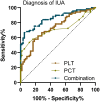Platelet Count and Platelet Hematocrit Correlate to the Occurrence and Postoperative Recurrence in Intrauterine Adhesion Patients
- PMID: 40351331
- PMCID: PMC12063616
- DOI: 10.2147/IJWH.S506075
Platelet Count and Platelet Hematocrit Correlate to the Occurrence and Postoperative Recurrence in Intrauterine Adhesion Patients
Abstract
Background: Platelet count (PLT) has been identified as a predictor for the development of pelvic adhesions. However, it remains unclear whether platelet-related parameters can also serve as indicators for the occurrence of intrauterine adhesions (IUA).
Methods: Patients diagnosed with IUA were included for further analysis, with platelet-related parameters assessed through routine blood tests. The predictive value of PLT and platelet hematocrit (PCT) was evaluated using receiver operating characteristic (ROC) curve analysis. Recurrence of IUA was determined based on a one-year follow-up.
Results: Our study included 69 IUA patients and 60 matched healthy women. We found that PLT and PCT levels were significantly elevated in IUA patients compared to the healthy controls. ROC analysis demonstrated that both PLT and PCT effectively predicted the occurrence of IUA. Additionally, higher PLT and PCT levels were noted in patients with recurrent IUA, suggesting their potential for predicting recurrence.
Conclusion: Elevated PLT and PCT levels were observed in patients with IUA and were further increased in those with recurrent cases. These findings suggest that high PLT and PCT levels may serve as valuable predictors for both the occurrence and recurrence of IUA. Specifically, the study is limited by the small sample size of recurrent IUA cases and potential confounders. These limitations should be considered when interpreting the findings.
Keywords: intrauterine adhesions; occurrence; platelet; platelet crit; recurrence.
© 2025 Wei et al.
Conflict of interest statement
The authors have no competing interest to declare in this work.
Figures





Similar articles
-
[Change of platelet parameters in septic shock patients].Zhonghua Wei Zhong Bing Ji Jiu Yi Xue. 2014 Jan;26(1):28-32. doi: 10.3760/cma.j.issn.2095-4352.2014.01.006. Zhonghua Wei Zhong Bing Ji Jiu Yi Xue. 2014. PMID: 24506853 Chinese.
-
Efficacy and prognostic factors of combined administration of progesterone and estriol valerate tablets for preventing intrauterine adhesions in patients with early missed abortion following dilation and curettage.Am J Transl Res. 2024 Jul 15;16(7):3164-3170. doi: 10.62347/AMEB4153. eCollection 2024. Am J Transl Res. 2024. PMID: 39114685 Free PMC article.
-
The predictive value of serum IL-17A and IL-6 expression in postoperative recurrence in patients with intrauterine adhesion.Am J Reprod Immunol. 2024 Jan;91(1):e13808. doi: 10.1111/aji.13808. Am J Reprod Immunol. 2024. PMID: 38282600
-
Short- and Long-term Outcomes of Postoperative Intrauterine Application of Hyaluronic Acid Gel: A Meta-analysis of Randomized Controlled Trials.J Minim Invasive Gynecol. 2022 Aug;29(8):934-942. doi: 10.1016/j.jmig.2022.05.006. Epub 2022 May 13. J Minim Invasive Gynecol. 2022. PMID: 35577245 Review.
-
Treatment strategies for intrauterine adhesion: focus on the exosomes and hydrogels.Front Bioeng Biotechnol. 2023 Aug 31;11:1264006. doi: 10.3389/fbioe.2023.1264006. eCollection 2023. Front Bioeng Biotechnol. 2023. PMID: 37720318 Free PMC article. Review.
References
LinkOut - more resources
Full Text Sources

